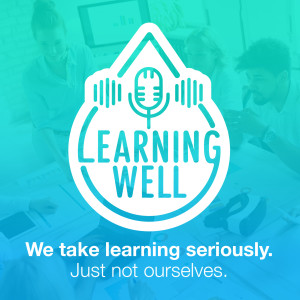
Monday May 30, 2022
Exploring How We Learn: A Deep Dive Into Brain Science - Learning Well Ep. 14
Join us as we talk brain science with Dr. Linda Haveman. Not only is she imminently qualified, she makes this complicated subject interesting and provides practical down-to-earth tips to apply to our learning experiences.
Segment One: The difference between neuroscience and cognitive science
Segment Two: Understanding the parts of the brain and how they function
Segment Three: How the brain processes information and its impact on learning
Segment Four: How neurodesign can impact workplace health and safety
Content outline
Neuroscience –Neuro = nerves/nervous system; science = systematic study; inner workings of the brain – cellular, functional, molecular, evolutionary, behavioral.
Cognitive science – study of emotions, perception, memory, knowledge, language and judgment. It involves many other sciences including neuroscience, psychology, linguistics, etc.
Biology of learning
- Neurons: 100 billion nerve cells
- cell body,
- dendrites, receives signals
- axon (transmits signals)
- myelin sheath - speed of signals by myelin sheath
Brain stem
- Controls most of body – breath, heart rate, sleep/wake
Limbic system
- Amygdala – emotions and memories generated, rage, fear, pleasure, short-term memory (however, memories are scattered all over the brain)
- Hippocampus – converts short term to long term memory
- Thalamus – senses – relays motor and sensory signals (except small) to the cerebral cortex
Frontal Cortex – executive processing, planning behavior, expressions, decisions, moderating social behavior
White matter -- gets color for the myelin sheath – that which insulates the axon
Cerebral cortex -- gray matter
Learning
- 70% hands-on (many employees do not just want a job aid, need to actually do the work)
- 20% social learning
- 10% formal – while small percent, critical to gain new information
- Must hear it, see it, question it, discuss it, and do it (teach it)
Memory stages
- Encoding – more attention, intake
- Storage
- Retrieval (go from amygdala to hippocampus for processing).
Content needs to be relevant and chunked
- 2-4 chunks at a time, drawing on a person’s memory, using questions to structure a mental model with
- Speed of talk – we can hear 400-500 words/minute. If the facilitator speaks slowly, minds get bored and wander
- Spacing effect (1885 by Hermann Ebbinghaus) == practice opportunities are spaced over time
- Give listeners a chance to internalize information every 8 minutes
- Job aides
- Retention – question of the day for review/practice (EM)
- Pop quizzes in the middle of training – neuron model, executive brain …
Choice of words are important. Biech in The Art and Science of Training notes that a single word can influence our physical and emotional stress. Whether they are positive or negative words, the changes can be noted on an fMRI (functional magnetic resonance imaging) scan. Increased activity occurs in the amygdala and hormones and neurotransmitters are released.
Relief of brain overload
- Stress hormones killing your brain
- Relax – interconnected regions suddenly become quite active (behind your forehead and toward the middle of your brain).
- LT memory relies on use of new information and transferred into the workplace. If not transferred, it will be pruned.
Work Environment
Green space, outdoors
- Get into the woods
- 12% decrease in cortisol; 7% decrease in nervous system; 6% lowering of heart rate
Room color:
- Color green – focus like a magnifying glass
- Blue = alert and aroused (suppresses melatonin hormone)
Room Size:
- Cathedral effect – focus on the gist of the problem
- Lower ceiling – focus on the details
People who spend less time on work statistically do their jobs more effectively than people who spend more time.
- Break every 90 minutes
- Moderate stress good
- Procrastination Is fueled by an attempt to avoid adverse feelings
Do activity at higher energy time of day
Exercise – or walk around your office – not matter the size – move
Naps in midafternoon – no longer than 30 minutes
Groups that excel (Medina)
Able to read each other’s cues
Take turns in conversation
Have more women
Books:
Andreatta, B. (2019). Wired to Grow: Harness the Power of Brain Science to Learn and Master any Skill
Andreatta, B. (2017). Wired to Resist: The Brain Science of Why Change Fails and a New Model for Driving Success.
Beich,E. (2016). The Art and Science of Training.
Jesen, E. & McConchie, Liesl. (2020). Brain Based Learning (3rd ed.).
Medina, J. (2021). Brain Rules for Work
No comments yet. Be the first to say something!